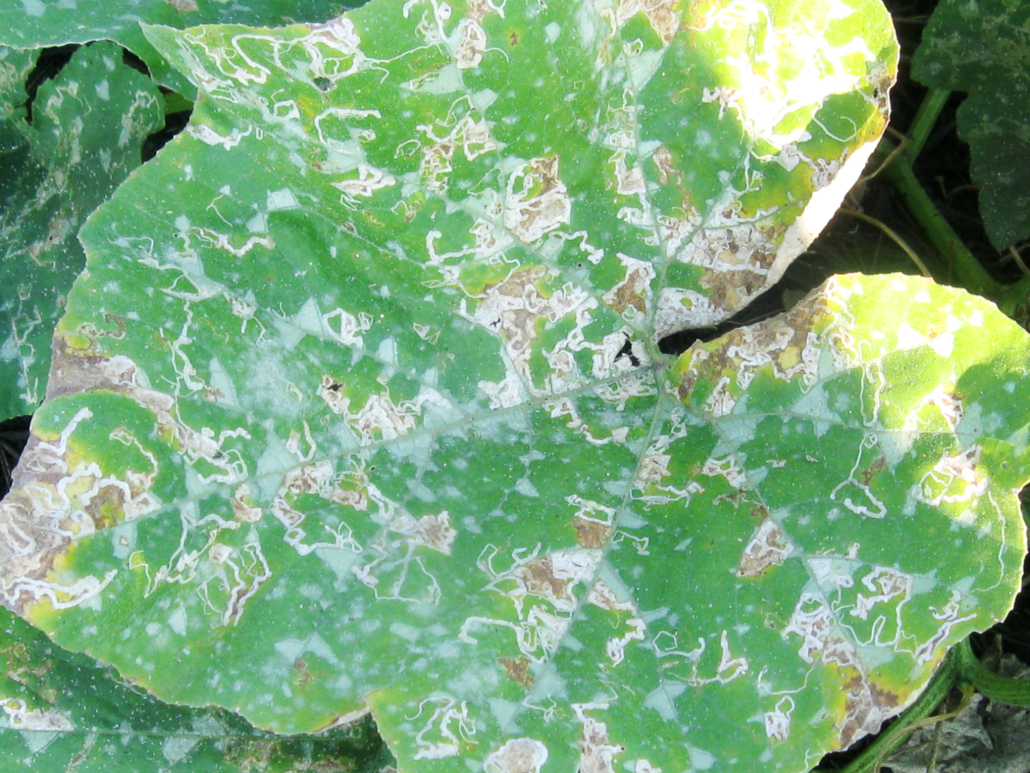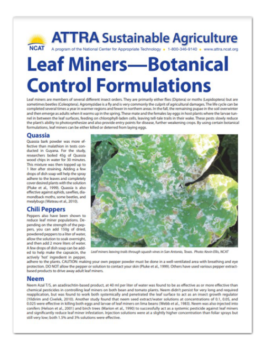Leaf Miners—Botanical Control Formulations

By Justin Duncan, NCAT Agriculture Specialist
Leaf miners are members of several different insect orders. They are primarily either flies (Diptera) or moths (Lepidoptera) but are sometimes beetles (Coleoptera). Agromyzidae is a fly and is very commonly the culprit of agricultural damages. The life cycle can be completed several times a year in warmer regions and fewer in northern areas. In the fall, the remaining pupae in the soil overwinter and then emerge as adults when it warms up in the spring. These mate and the females lay eggs in host plants where the larvae tunnel in between the leaf surfaces, feeding on chlorophyll-laden cells, leaving tell-tale trails in their wake. These pests slowly reduce the plant’s ability to photosynthesize and also provide entry points for disease, further weakening crops. By using certain botanical formulations leaf miners, can be either killed or deterred from laying eggs.
Quassia
Quassia bark powder was more effective than malathion in tests conducted in Guyana. For the study, researchers boiled 45g of Quassia wood chips in water for 30 minutes. This mixture was then topped up to 1 liter after straining. Adding a few drops of dish soap will help the spray adhere to the leaves and completely cover desired plants with the solution (Pluke et al., 1999). Quassia is also effective against aphids, sawflies, diamondback moths, some beetles, and mealybugs (Wateau et al., 2010).
Chili Peppers
Peppers also have been shown to reduce leaf miner populations. Depending on the strength of the peppers, you can add 150g of dried, powdered peppers to a liter of water, allow the solution to soak overnight, and then add 2 more liters of water. A few drops of dish soap can be added to help make the capsaicin, the actively ‘hot’ ingredient in pepper, adhere to the plants. CAUTION: making your own pepper powder must be done in a well-ventilated area with breathing and eye protection. DO NOT allow the pepper or solution to contact your skin (Pluke et al., 1999). Others have used various pepper extract-based products to drive away adult leaf miners.
Neem
Neem Azal T/S, an azadirachtin-based product, at 40 ml per liter of water was found to be as effective as or more effective than chemical pesticides in controlling leaf miners on both bean and tomato plants. Neem didn’t persist for very long and required reapplication, but was found to work both systemically and penetrated the leaf surface to act as an insect growth regulator (Yildirim and Civelek, 2010). Another study found that neem seed extract/water solutions at concentrations of 0.1, 0.05, and 0.025 were effective in killing both eggs and larvae of leaf miners on lima beans (Webb et al., 1983). Neem was also injected into conifers (Helson et al., 2001) and birch trees (Marion et al., 1990) to successfully act as a systemic pesticide against leaf miners and significantly reduce leaf miner infestation. Injection solutions were at a slightly higher concentration than foliar sprays but still very low; both 1.5% and 3% solutions were effective.
Walnut Leaves
Walnut leaf extract, principally Juglone, was found to reduce leaf miner damage to less than 3% but requires weekly application to maintain efficacy. In one study, researchers produced a tincture by extracting the phytochemicals from powdered leaves with ethyl alcohol. They used 50 g of material and 250 ml of pure ethanol in a Soxhlet apparatus (Rizvi et al., 2015). This can be done at home with 50% or higher clear alcohol such as vodka. Fill a quart-sized mason jar with dried walnut or black walnut leaves, cover with alcohol, and let sit for eight weeks. After this time, the liquid should be poured through cheesecloth into a dark-colored, glass storage container. The leaves also should be squeezed through cheesecloth into the container. This extract should be mixed with water in a spray bottle and applied weekly to discourage leaf miners from depositing eggs on plants. As with all botanicals, strength of the solution will depend on many factors so when testing a newly made product start off with a weaker solution, less than 5%, and work incrementally up until the desired results are achieved without causing harm to the treated plant. This will be relative and very case specific due to potency at an individual plant level. This is due to differences in soil, nutrition status of the plant, the weather and UV intensity. Phytotoxity usually appears in the form of curling leaves, drying leaves, or dead leaf edges. This process will also work with almond leaves.
For additional information, see the ATTRA Sustainable Pest and Weed Control Database and the ATTRA publication Companion Plants and Botanical Pesticides.
References
Helson, B.V., D.B. Lyons, K.W. Wanner, T.A. Scarr. 2001. Control of conifer defoliators with neem-based system bioinsecticides using a novel injection device. The Canadian Entomologist. 09. 133(5):729-744.
Marion, D.F., H.G. Larew, J.J. Knodel, W. Natoli. 1990. Systemic Activity of Neem Extract Against the Birch Leafminer. Journal of Aboriculture. 16:1 January.
Pluke, R., D. Permaul, and G. Leibee. 1999. Integrated Pest Management and the Use of Botanicals in Guyana. Inter-American Institute on Agricultural Cooperation. P.O. Box 10-1089, Georgetown, Guyana.
Rizvi, S.A.H., M.N. Ikhlaq, S. Jaffar, S. Hussain. 2015. Population Dynamics, Efficacy of Botanical Extracts and Synthetic Insecticides for The Control of Pea Leaf M iner (Phytomyza horticola Goureau) (Diptera: Agromyzidae) Under the Climatic Conditions of Baltistan, Pakistan. International Journal of Applied Research. 1(12): 758-761.
Wateau, K., M. Legrand, L. Tournant, and L. Jamar. 2010. Importance of Quassia amara and Plant Extracts in Protecting Crops. Proceedings of the European Symposium of the Technical Institute for Organic Agriculture (ITAB): Plant Protection Products for Organic Agriculture. March 10-11.
Webb, R.E., M.A. Hinebaugh, R.K. Lindquist, M. Jacobson. 1983. Evaluation of Aqueous Solution of Neem Seed Extract Against Liriomyza sativae and L. trifolii (Diptera: Agromyzidae). Journal of Economic Entomology 03. 76(2):357-362.
Yildirim, E.M., H.S. Civelek. 2010. Effects of different insect growth regulators (IGR) on the vegetable leafminer Liriomyza sativae Blanchard (Diptera: Agromyzidae). Fresenius Environmental Bulletin Vol 19/No 11. p. 2562-2566.
Leaf Miners—Botanical Control Formulations
By Justin Duncan, NCAT Agricultural Specialist
Published August 2016
©NCAT
IP521
Slot 547
This publication is produced by the National Center for Appropriate Technology through the ATTRA Sustainable Agriculture program, under a cooperative agreement with USDA Rural Development. This publication was also made possible in part by funding from the National Institute of Food and Agriculture, U.S. Department of Agriculture, grant award number 2013-51106-20970. ATTRA.NCAT.ORG.


